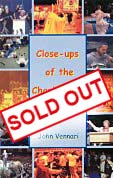A September 6 press release from the ecumenical community of Taizé says that to suggest Brother Roger Schutz converted to Catholicism before his death is to "misrepresent his intentions" and "defame his memory."
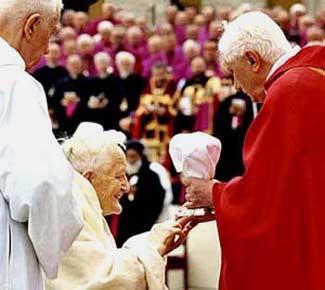
Cardinal Ratzinger gives Communion in the hand to Protestant brother Roger at John Paul II's funeral Mass | |
This is strong language in an age of supposed ecumenical sensitivity. Taizé states publicly that to regard a non-Catholic's alleged conversion to Catholicism is "defamation." It demonstrates the true anti-Catholic nature of modern ecumenism.
Taizé was responding to a recent report that claimed Brother Roger had become a Catholic. Yves Chiron, a respected Catholic historian, published in France that Brother Roger had converted to Catholicism, but in a "discreet" manner, so discreet that very few people knew about it.
The Remnant, who received the newsletter from Mr. Chiron, translated the French article into English and published it, though Editor Michael Matt noted in the article's introduction that he did not necessarily regard Mr. Chiron's arguments as convincing.
Mr. Chiron wrote of Brother Roger: "This 'passage,' this conversion took place in 1972, in the chapel of the Bishop of Autun, the diocese where Taizé is located. There was the profession of the Catholic Faith, then Communion was given by Msgr. Le Bourgeois. No written certificate remains, it seems, of that event, but Brother Roger has given oral testimony of it and of his adherence to the Catholic Faith to the successor of Mgr. Le Bourgeois, Mgr. Seguy." (1)
1. "Did Brother Roger Schutz Convert?" Yves Charin, The Remnant, August 31, 2006.
Mr. Chiron went on to speak of traditional Catholics who fault Card. Ratzinger for giving Brother Roger Communion at Pope John Paul II's funeral Mass: "It is in bad form to accuse him [Card. Ratzinger] still today of `having given communion to a Protestant.'" Chiron footnotes, "the accusation surfaces in the process of speaking against Benedict XVI on French and American web sites and certain traditionalists reviews."
Whether he intended it or not, Mr. Chiron's comments gave the impression that perhaps traditional Catholic publications, such as Catholic Family News, reported that Card. Ratzinger "gave Communion to a Protestant" without first investigating the facts. In fact, the opposite is true.
Last year, I published a piece entitled "Pope Benedict XVI and Eucharistic Sacrilege". Here I reported the sad truth that Card. Ratzinger had given Communion to the Protestant Brother Roger at Pope John Paul II's funeral Mass.
Before writing the article I telephoned Taizé in France to ask if Brother Roger had become Catholic. I wanted to be certain, since Fr. Richard Neuhaus said on an EWTN broadcast that Brother Roger had converted to Catholicism and "was now a Catholic priest."
An English-speaking representative of Taizé told me that Brother Roger, who was still alive at the time, had not converted to Catholicism, but was still a Protestant.
Then in mid-September, after Brother Roger's murder, rumors again circulated about Brother Roger's conversion. On September 15, 2005, I telephoned Taizé once again to ask if Brother Roger had become Catholic.
"Oh no," said Brother Johannes, a member of the community, "that is not true." Brother Johannes assured me that Brother Roger did not convert to the Catholic Church before his death. Taize's recent press release confirms the fact of Brother Roger's non-conversion.
Intercommunion: Sacrament of ecumenists
It is worth noting, as I did last year, that Card. Ratzinger had already acquired a reputation for giving Communion to Protestants, so the scandal of Brother Roger was not an isolated occurrence. An April 15 UPI report by Uwe Siemon-Netto said:
"While Ratzinger played an important role in the drafting of the papal encyclical Ecclesia de Eucharistia (Church of the Eucharist), which generally rules out intercommunion between Catholics and Protestants, he is known to have made some remarkable exceptions to this rule himself.
"At the funeral Mass for Pope John Paul II, Ratzinger communed the Rev. Roger Schutz, a Swiss Protestant pastor and founder of the Taizé ecumenical community in France.
"A German Lutheran theologian well known to the cardinal told UPI that he, too, received the sacrament from his [Ratzinger's] hands."(2)
The same UPI writer applauds Card. Ratzinger as an ardent ecumenist:
"Benedict XVI, arguably the foremost Catholic theologian of our time, has always been an ecumenist, though never a fuzzy one. If he gives the Sacrament to a member of another Christian church — and Schutz was not the only one — he makes it abundantly clear he considers this person a fellow member of the mystical body of Christ.
"This is not the way narrow-minded blockheads behave." (3)
2. "At 78, Ratzinger a Rising Star", Uwe Siemon-Netto, UPI, April 15, 2005.
3. "Upright but no Panzer Pope," UPI, April 20, 2005.
Around the same time, Protestant John Armstrong rejoiced at the election of Card. Ratzinger to the papacy because of the Cardinal’s ecumenical bent:
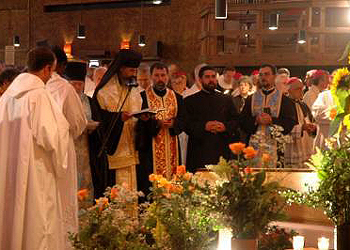
The ecumenical funeral of Roger Schutz | |
"Another reason I am pleased with the choice of Ratzinger [as Pope] has generally been missed by the main-stream media. During the memorial service for John Paul II, Card. Ratzinger quietly communed Brother Roger Schutz, the Swiss Protestant Pastor and founder of the ecumenical community in Taize, France. This simple, humble, courageous act would not have been done in centuries past. It demonstrates that Ratzinger not only believes Schutz to be a member of the body of Christ, but a member who should receive the Sacrament. As one Protestant commentator wrote last week, `This is not the way narrow-minded blockheads behave.’"(4)
According to the New York Times, intercommunion was featured at Brother Roger's funeral service, celebrated by the Vatican's Walter Kasper. The Times headlined the sacrilege: "At His Funeral, Brother Roger has an Ecumenical Dream Fulfilled":
"Brother Roger Schutz pursued many ecumenical dreams in his long life, but in death one of them came true. At a Eucharistic service celebrated Tuesday [Aug. 23] by a Roman Catholic Cardinal for Brother Roger, a Swiss Protestant, Communion wafers were given to the faithful indiscriminately, regardless of de-nomination.
"Card. Walter Kasper, the president of the Vatican Council for Unity of Christians, who celebrated the Mass, said in the homily, `Yes, the springtime of ecumenism has flowered on the hill of Taize.’” (5)
4. "A Prayer for Pope Benedict XVI," John H. Armstrong, Center for Cultural Leadership. From the Internet.
5. "At His Funeral, Brother Roger has an Ecumenical Dream Fulfilled," John Tagliabue, New York Times, August 24, 2005.
Thus, sacrilegious inter-communion is considered a sign of springtime, and any Catholic who insists on observing the Church's age-long prohibition against non-Catholics receiving Communion is a "narrow-minded blockhead". Such is the abysmal state of the Catholic Church under Pope Benedict XVI.
He went along "discovering"
Taize's press release claims that Brother Roger embraced the Catholic Faith but still remained a Protestant, whatever that means.
In order to reinforce this confusion, Taizé also posted a webpage interview with the new "Catholic" superior Brother Alois. Here Brother Alois said, "No. Brother Roger never 'converted' formally to Catholicism. If he had, he would have said so; for he never hid anything about the path he was following. All through his books, often written in the form of a journal, he explained as he went along what he was discovering and what he was living.”
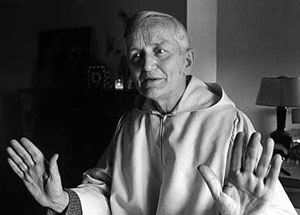
Schutz never said he converted to the Catholic Faith | |
This is essentially a Protestant approach: the individual decides for him-self what it means to be a "Christian" and structures his life accordingly, independent from the perennial teaching of the Catholic Church. This is precisely what Brother Roger did.
What happened, then, in 1972? Brother Alois answers, "In 1972, the then Bishop of Autun, Msgr. Armand Le Bourgeois, simply gave him Communion for the first time, without requiring any other profession of faith from him besides the Creed recited during the Eucharist, and which is held in common by all Christians. Several witnesses were present, three of my brothers, a couple who are friends of ours; they can attest to this."
Brother Alois explains, "That date was chosen because Brother Roger was preparing to receive the life commitment of the first Catholic brother of the community and it was unthinkable not to receive communion at the same Eucharistic table. Several months later, Mgr. Le Bourgeois came to Taize, and, in the same way, gave Communion to all the brothers of the community."
Here we see three main points:
1. Brother Alois insists that Brother Roger never converted to Catholicism, but became some sort of half-and-half creature, part Protestant, part "Catholic";
2. The Bishop of Autun, in a dereliction of duty, deemed a simple recitation of the Creed sufficient to give Communion to a non-Catholic. This, to use the words of Protestant John Armstrong, "would not have been done in centuries past" and set the stage for further "intercommunion";
3. The same Bishop of Autun "gave Communion to all the brothers of the community" when only one of the `professed' Brothers at the time was Catholic, implying he administered Communion to Catholics and Protestants alike. Who will make reparation for this sacrilege based on false sentiment?
"I have found my own identity"
Brother Alois says of Brother Roger: "Of Protestant origin, he accomplished something that was without precedent since the Reformation. In 1980, during a European young adult meeting in Rome, he expressed this publicly in the following terms in St. Peter's Basilica, in presence of Pope John Paul II, `I have found my own identity as a Christian by reconciling within myself the faith of my origins with the mystery of the Catholic faith, without breaking fellow-ship with anyone.'"
If Brother Roger appears to be confusing, it is because he is confusing. Brother Roger's hazy words reinforce what the Protestant Dr. Visser't Hooft's admitted in the 1950s: "The simple ABC's of ecumenism" is that "there is no ecumenical language which is completely unambiguous." (6)
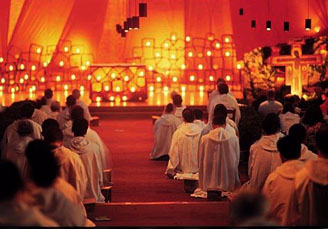
A strange ecumenical prayer for all religions at Taizé | |
When Brother Roger says, "I have found my own identity," it appears he saw himself as a kind of protoecumenical Christian; a new creation unlike any-thing before. In doing so, whether he realized it or not, whether he was well-meaning or not, he displayed a contempt for the unchanging teaching of the Catholic Church, which insists that those outside of her must abandon their heretical positions and enter into the one true Church established by Our Lord.
The Council of Florence defined infallibly that "Pagans, Jews, heretics and schismatics" are "outside the Catholic Church," and as such, "can never be partakers of eternal life," unless "before death" they are joined to the one true Church of Jesus Christ, the Catholic Church.(7)
The Catechism of the Council of Trent, faithful to this truth, teaches, "infidels, heretics, schismatics and excommunicated persons" are "excluded from the Church's pale." (8) In other words, Protestants, Jews, Muhammadans, Hindus, Buddhists, etc., are not part of the Catholic Church, which is the Kingdom of God on earth. (9)
The Catechism of Pope St. Pius X, centuries later, presents the same truth without change: "Outside the true Church are: Infidels, Jews, heretics, apostates, schismatics and excommunicated persons". It states further, "No one can be saved outside the Catholic, Apostolic, and Roman Church, just as no one could be saved from the flood outside the Ark of Noah, which was a figure of the Church." (10)
6. Cited in article from The Ecumenical Review, VIII, January, 1956.
7. Bull Cantate Domino issued by Pope Eugene IV at the Council of Florence, February 4, 1442.
8. Catechism of the Council of Trent, McHugh & Callan Translation, (Rockford: Tan, Reprinted 1982), p.101.
9. Msgr. Joseph Clifford Fenton explains that the word "Church" has a very definite meaning. It means, the Kingdom of God on earth, the People of the Divine Covenant, the one social unit outside of which no one can be saved. See "The Meaning of the Word 'Church'," Msgr. Fenton, American Ecclesiastical Review, October, 1954. republished in the November 2000 Catholic Family News.
10. The Catechism of Pope Saint Pius X, (First published in 1910, republished by Instaratio Press, Australia), pp. 31, 41.
Brother Roger ignored these divine truths, and constructed a new ecumenical model by which he journeyed through ongoing "discoveries."
Much worse than Brother Roger's approach, however, are Catholic churchmen, prelates and pontiffs who heap unqualified praise over this new kind of ‘Christian.’ These churchmen, whatever their rank, display a contempt for the consistent teaching of the Popes throughout the centuries and for the infallible Catholic dogma "outside the Church there is no salvation." They also show themselves to be imbued with the poison of Modernism, which holds that Catholic truth changes over time; so that a 21st Century Catholic will have a new understanding of what it means to be a member of the Church, different from the understanding of a 19th Century Catholic.
Churchmen who accept and promote such nonsense defy the infallible dogma of Vatican I, which holds that Catholics must accept Catholic teaching as it has always been taught throughout the centuries, (eodem sensu eademque sententia) "with the same meaning and in the same explanation." (11) These churchmen also betray their Oath Against Modernism, in which they vowed to God to always accept Catholic teaching without change, "with the same meaning and in the same explanation." (12)
11. Vatican I's Dei Filius says clearly, "Let therefore the understanding, the knowledge and the wisdom of individual men, and of all men of one man, and of the entire Church, grow and advance greatly and powerfully, over the course of the years and the ages, but only in its own class, in the same dogma, with the same meaning and in the same explanation." — Translation from "Two Statements About the Necessity of the Catholic Church for the Attainment of Eternal Salvation," Msgr. Joseph Clifford Fenton, American Ecclesiastical Review, June 1962, p. 408.
12. The man who takes this Oath makes the following promise, 'I sincerely receive the doctrine of faith handed down to us from the Apostles through the orthodox Fathers, with the same meaning and the same explanation (eodem sense eademque sententia); and consequently I completely reject the heretical fiction of an evolution of dogma, changing from one meaning to another, different from that which the Church first held." Ibid.
Conversion: A dirty word
Brother Alois further explains Brother Roger's novel approach: "To speak in terms of `conversion' is not to understand the originality of what Brother Roger was seeking. The word `conversion' is weighed down with history; `conversion' implies a break with your origins. Brother Roger accepted that for some an individual conversion might be a way, but for himself and for our community he preferred to speak of communion. For him, entering progressively into a full communion with the Catholic Church was given concrete expression in two points he never kept secret: receiving the Eucharist and recognizing the necessity of a ministry of unity exercised by the Bishop of Rome."
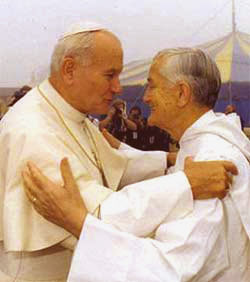
John Paul II and Schutz | |
Brother Roger appears similar to the ecumenical Protestant denounced by Pope Pius XI's Mortalium Animos. Here, Pope Pius XI warned against ecumenists who, while remaining Protestant, were willing to grant the Roman Pontiff a primacy of honor, and even a certain jurisdiction of power, and who "wish the Pontiff Himself to preside over their motley, so to say, assemblies."
It seems Brother Roger adopted this false understanding as his own, calling it the "Ministry of unity exercised by the Bishop of Rome." Brother Roger thus wasted his life “discovering" old errors already condemned.
Pope Pius XI in Mortalium Animos cuts through the haze and poses the question that could have been dead-aimed at Brother Roger:
"For if, as they continually state, they long be united with Us and ours, why do they hasten to enter the Church, `the Mother mistress of all Christ’s faithful'? Let them hear Lactantius crying out: `The Catholic Church is alone in keeping the true worship. This is the fount of truth, this the house of Faith, this the temple of God: if any man enter not here, or if any man go forth from it, he is a stranger to the hope of life and salvation. Let none delude himself with obstinate wrangling. For life and salvation are here concerned, which will be lost and entirely destroyed, unless their interests are carefully and assiduously kept in mind'."
Brother Roger was thus a Christian on his own terms, not on the terms of Christ who founded His Catholic Church as the one and only social unit for salvation.
At root is Vatican II
The entire controversy surrounding the founder of Taizé stems from the new heterodox tenet from Vatican II that posits the Church of Christ as something bigger than the Catholic Church.
Pope Pius XII, in accordance with the authentic magisterium of all time, taught that the Mystical Body of Christ and the Catholic Church are one and the same thing. (13) The progressivists at Vatican II introduced the false concept that the Church of Christ, as Fr. Avery Dulles put it, "is not exclusively identical with the Roman Catholic Church.” (14)
13. In the 1943 encyclical Mystici Corporis, Pope Pius XII taught that "the true Church of Jesus Christ ... is the One, Holy, Catholic, Apostolic Roman Church? (Mystici Corporis, Pope Pius XII, N.C.W.C. edition, 1943, No. 13, p. 8.) This clearly means that the Church of Christ is not composed of the Catholic Church and other 'Christian" denominations. Pope Pius XII reiterated this doctrine in his 1950 encyclical Human i Generis: 'The Mystical Body of Christ and the Roman Catholic Church are one and the same thing'. In the same paragraph, Pius complained of those who “reduce to a meaningless formula the necessity of belonging to the true Church in order to gain eternal salvation?” (Humani Genesis, Pope Pius XII, N.C.W.C. edition, 1950, No. 27, p. 12.)
14. The Progressivist Fr. Avery Dulles wrote, `The Church of Jesus Christ is not exclusively identical to the Roman Catholic Church. It does indeed subsist in Roman Catholicism, but it is also present in varying modes and degrees in other Christian communities to the extent that they too are what God initiated in Jesus and are obedient to the inspirations of Christ's Spirit. As a result of their common sharing in the ,reality of the one Church, the several Christian communities already have with one another a real but imperfect communion.' Quoted in Vatican ll, the Work That Needs to Be Done, ed. by David Tracy with Hans Kung and Johann Metz, (Concillium, Seabury Press, NY, 1978), p. 91 (emphasis added)
The progressivist Fr. Joseph Ratzinger in 1966 rejoiced that the Council document Lumen Gentium did not use the scholastic term "member of the Church" since the term "member of the Church," according to the scholastic understanding, "could only be applied to Catholics," and this was unacceptable. This scholastic understanding was based on Saint Robert Bellarmine's clear teaching that membership required baptism, profession of the same faith and acceptance of the hierarchy headed by the Pope. This, Fr. Ratzinger complained, was a "very narrow formulation."(15)
Fr. Ratzinger also rejoiced that Lumen Gentium abandoned the notion of conversion of non-Catholics to replace it with the principle of convergence with non-Catholics. Con-version is merely an option. (16)
Robert McAffee Brown, a Protestant observer at the Council, likewise celebrated that Vatican II documents take an ecumenical approach and do not call for the conversion of Protestants:
“No more is there an imperial demand that the dissidents return in penitence to the Church who has no need of penitence; instead there is recognition that both sides are guilty of the sins of division and must reach out penitentially to one another." (17)
15. Joseph Ratzinger, "Theological Highlights of Vatican II" (New York: Paulist press, 1966), p. 61.
16. For a fuller treatment of this subject, see "Vatican II vs. the Unity Willed by Christ", J. Vennari, CFN, Dec. 2000 (Reprint #2023 available from CFN for $2.00).
17. The Ecumenical Revolution, Robert McAfee Brown. (Garden City: Doubleday, 1967, 2nd ed. 1969), pp. 67-8.
This is the root error of our time, an error imbedded in the brains of the Church's highest authorities; that the Church of Christ is bigger than the Catholic Church, containing Catholics and Protestants alike.
It is this error that is responsible for the modern scandal of intercommunion. It is this error that says Brother Roger and other Protestants are "fellow members of the Mystical Body of Christ". It is this error that cheats Protestants out of being told the truth that they must convert to Christ's one true Catholic Church for salvation.
No Catholic is bound to accept this new Conciliar error, since Vatican I teaches infallibly that not even a Pope may change Catholic doctrine. (18) If a Pope attempts to do so, then as Saints and Popes of the past instruct us, he must be resisted.(19)
18. "The Holy Spirit was not promised to the successor of Peter that by the revelation of the Holy Spirit they might disclose new doctrine, but that by His help they might guard sacredly the revelation transmitted through the Apostles and the deposit of Faith, and might faithfully set it forth." [Vatican I, Session IV, Chapter IV; Pastor Aetemus.] No authority in the Church, not even a Pope, may lawfully attempt to change the clear meaning of infallible dogma, including the thrice defined dogma that "outside the Catholic Church there is no salvation". Neither may anyone, no matter how highly placed, change the meaning of doctrine in- the name of a newer or "deeper" understanding. Vatican I taught: "The meaning of Sacred Dogmas, which must always be preserved, is that which our Holy Mother the Church has determined. Never is it permissible to depart from this in the name of a deeper understanding." [Vatican I, Session III, Chap. IV, Dei Filius].
19. For example, Saint Robert Bellarmine taught, "Just as it is licit to resist the Pontiff that aggresses the body, it is also licit to resist the one who aggresses souls or who disturbs civil order, or, above all, who attempts to destroy the Church. I say that it is licit to resist him by not doing what he orders and by preventing his will from being executed; it is not licit, however, to judge, punish or depose him, since these acts are proper to a superior." Bellarmine, De Romano Pontifice, Book II, Chapter 29.
Let your Yes be Yes!
Brother Roger was a Lutheran who embraced "Catholicism" without ever becoming Catholic, and without ever renouncing his Protestantism. As such, he was a walking contradiction who believed he reconciled the irreconcilable. Catholics must not accept the patronizing put-down in Taize's statement that Brother Roger was simply misunderstood, implying he pursued a path only the enlightened could under-stand. This is a false superiority, a kind of spiritual snobbery that reeks of Gnosticism.
Perhaps we could call Brother Roger a Hegelian Christian — a new synthesis that combines thesis and antithesis. He was a walking embodiment of the New Mass — being both Protestant and "Catholic". He is, no doubt, a kind of model for the Novus Ordo Church — a terrifying glimpse of what the new "Christian" might be.
One can only wonder if Brother Roger would have converted had he lived under pre-Conciliar popes from whom he would have received solid Catholic guidance. As it happened, Brother Roger became an ecumenical guru; a false prophet who carved out his own idea of Christianity, and trampled underfoot the perennial teaching of the Catholic Church to the applause of a modernist hierarchy.

Posted October 26, 2006
|
